Chapter 9 nsg 5003 - Study guides, Class notes & Summaries
Looking for the best study guides, study notes and summaries about Chapter 9 nsg 5003? On this page you'll find 29 study documents about Chapter 9 nsg 5003.
Page 3 out of 29 results
Sort by
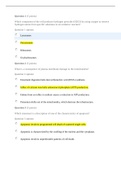
-
NSG 5003-Final Exam Questions and Answers
- Exam (elaborations) • 19 pages • 2021
-
- $10.99
- + learn more
NSG 5003-Final Exam Questions and Answers Question 1 (5 points) Which component of the cell produces hydrogen peroxide (H2O2) by using oxygen to remove hydrogen atoms from specific substrates in an oxidative reaction? Question 1 options: Lysosomes Peroxisomes Ribosomes Oxyhydrosomes Question 2 (5 points) What is a consequence of plasma membrane damage to the mitochondria? Question 2 options: Enzymatic digestion halts deoxyribonucleic acid (DNA) synthesis. Influx of calcium ions ha...
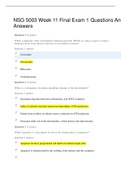
-
NSG 5003 Week 11 Final Exam 1 Questions And Answers
- Exam (elaborations) • 20 pages • 2021
-
- $18.49
- + learn more
NSG 5003 Final: Advanced pathophysiology: South University Question 1 (5 points) Which component of the cell produces hydrogen peroxide (H2O2) by using oxygen to remove hydrogen atoms from spe cific substrates in an oxidative reaction? Question 2 (5 points) What is a consequence of plasma membrane damage to the mitochondria? Question 3 (5 points) Which statement is a description of one of the characteristics of apoptosis? Question 4 (5 points) During cell injury caused by hypoxia, sodium and wat...
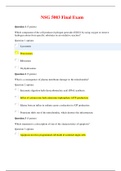
-
NSG 5003 FINAL EXAM / NSG5003 FINAL EXAM (VERSION-1, LATEST- 2020): ADVANCED PATHOPHYSIOLOGY: SOUTH UNIVERSITY |100% CORRECT ANSWERS, DOWNLOAD TO SCORE A|
- Exam (elaborations) • 19 pages • 2020
- Available in package deal
-
- $18.49
- + learn more
NSG5003 Final Exam / NSG 5003 Final Exam: Advanced pathophysiology: South University South University NSG5003 Final Exam / South University NSG 5003 Final Exam Question 1 (5 points) Which component of the cell produces hydrogen peroxide (H2O2) by using oxygen to remove hydrogen atoms from specific substrates in an oxidative reaction? Question 1 options: Lysosomes Peroxisomes Ribosomes Oxyhydrosomes Question 2 (5 points) What is a consequence of plasma membrane damage to the mitocho...
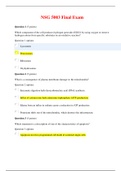
-
SOUTH UNIVERSITY NSG5003 ADVANCED PATHOPHYSIOLOGY FINAL EXAM 2020 (VERSION-1)|100% CORRECT ANSWERS, DOWNLOAD TO SCORE A|
- Exam (elaborations) • 19 pages • 2020
- Available in package deal
-
- $18.49
- + learn more
NSG5003 Final Exam / NSG 5003 Final Exam: Advanced pathophysiology: South University South University NSG5003 Final Exam / South University NSG 5003 Final Exam Question 1 (5 points) Which component of the cell produces hydrogen peroxide (H2O2) by using oxygen to remove hydrogen atoms from specific substrates in an oxidative reaction? Question 1 options: Lysosomes Peroxisomes Ribosomes Oxyhydrosomes Question 2 (5 points) What is a consequence of plasma membrane damage to the mitocho...
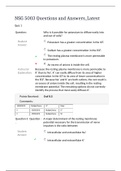
-
NSG 5003 Questions and Answers_Latest,100% CORRECT
- Exam (elaborations) • 43 pages • 2021
-
- $19.49
- 1x sold
- + learn more
NSG 5003 Questions and Answers_Latest Quiz 1 Question : Why is it possible for potassium to diffuse easily into and out of cells? Student Answer: Potassium has a greater concentration in the ICF. Sodium has a greater concentration in the ECF. The resting plasma membrane is more permeable to potassium. An excess of anions is inside the cell. Instructor Explanation: Because the resting plasma membrane is more permeable to K+ than to Na+, K+ can easily diff...
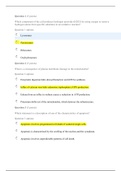
-
NSG 5003 Final Exam Week 10: Advanced Pathophysiology: South University, Graded A+
- Exam (elaborations) • 19 pages • 2019
- Available in package deal
-
- $10.49
- 3x sold
- + learn more
NSG 5003 Final Exam Week 10: Advanced Pathophysiology: South University 1. Which component of the cell produces hydrogen peroxide (H2O2) by using oxygen to remove hydrogen atoms from specific substrates in an oxidative reaction? 2. What is a consequence of plasma membrane damage to the mitochondria? 3. Which statement is a description of one of the characteristics of apoptosis? 4. During cell injury caused by hypoxia, sodium and water move into the cell because: 5. What is an effect of ionizing ...
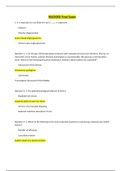
-
SOUTH UNIVERSITY NSG 5003 PATHOPHYSIOLOGY FINAL EXAM 2021 (2 VERSIONS): ADVANCED PATHOPHYSIOLOGY |100% CORRECT Q & A, DOWNLOAD TO SECURE HIGHSCORE|
- Exam (elaborations) • 72 pages • 2021
- Available in package deal
-
- $25.49
- + learn more
SOUTH UNIVERSITY NSG 5003 PATHOPHYSIOLOGY FINAL EXAM 2021 (2 VERSIONS): ADVANCED PATHOPHYSIOLOGY |100% CORRECT Q & A, DOWNLOAD TO SECURE HIGHSCORE| NSG5003 Final Exam / NSG 5003 Final Exam: Advanced pathophysiology: South University South University NSG5003 Final Exam / South University NSG 5003 Final Exam Question 1 (5 points) Which component of the cell produces hydrogen peroxide (H2O2) by using oxygen to remove hydrogen atoms from specific substrates in an oxidative reaction? Quest...
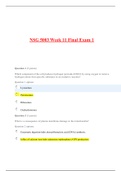
-
NSG 5003 Week 11 Final Exam 1
- Exam (elaborations) • 19 pages • 2021
-
- $20.49
- + learn more
NSG 5003 Final: Advanced pathophysiology: South University Question 1 (5 points) Which component of the cell produces hydrogen peroxide (H2O2) by using oxygen to remove hydrogen atoms from specific substrates in an oxidative reaction? Question 2 (5 points) What is a consequence of plasma membrane damage to the mitochondria? Question 3 (5 points) Which statement is a description of one of the characteristics of apoptosis? Question 4 (5 points) During cell injury ca...
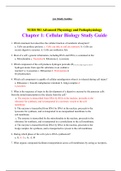
-
NURS 501 Advanced Physiology and Pathophysiology Chapter 1: Cellular Biology Study Guide/Exam (elaborations) NSG 5003/NSG 5003
- Exam (elaborations) • 113 pages • 2021
-
- $20.49
- + learn more
NURS 501 Advanced Physiology and Pathophysiology Chapter 1: Cellular Biology Study Guide/Exam (elaborations) NSG 5003/NSG 5003 501 Study Guides NURS 501 Advanced Physiology and Pathophysiology Chapter 1: Cellular Biology Study Guide 1. Which statement best describes the cellular function of metabolic absorption? a. Cells can produce proteins. c. Cells can take in and use nutrients. b. Cells can secrete digestive enzymes. d. Cells can synthesize fats. 2. Most of a cell’s genetic information, in...

Did you know that on average a seller on Stuvia earns $82 per month selling study resources? Hmm, hint, hint. Discover all about earning on Stuvia


